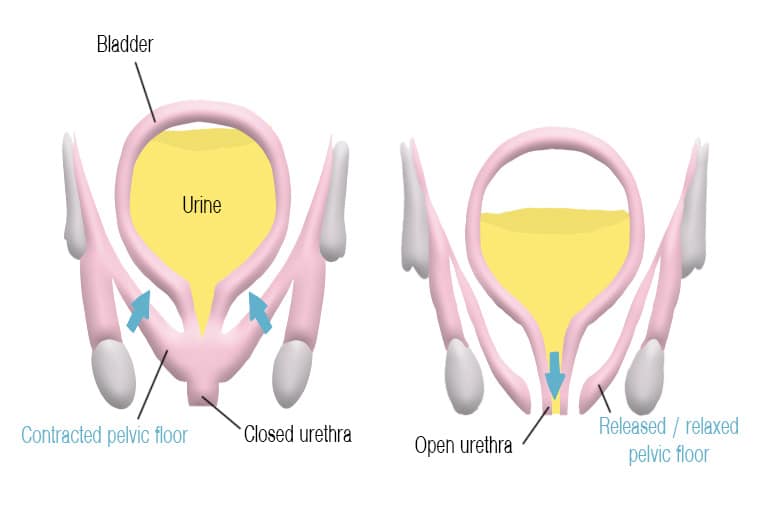
How can sport lead to pelvic floor dysfunction?
The pelvic floor fulfills a supporting function of the pelvic organs. Thus, the pelvic floor plays an important role, especially in sports. Think of the pelvic floor as support that adapts to our movements and breathing. Depending on the sport, the pelvic floor is more or less required. In sports such as cycling, swimming, or inline skating, the impact on the pelvic floor is relatively low. Other sports, such as running or trampolining, request the pelvic floor much more. Pelvic floor dysfunction can then occur in the long term.

Urinary leaks
To avoid unwanted urinary leaks, the closure pressure of the sphincter has to be higher than the pressure that the urine applies to come out.

During intense abdominal contractions, the stomach presses on the bladder and the sphincter muscle can no longer retain the urine. When you run, you do not lose urine immediately. The sphincter muscles get tired and become less effective. This can cause urine to leak out unintentionally while exercising.
Prolapse
The pelvic floor supports the bladder, the uterus, and the rectum. With repeated shocks, these muscles and supportive ligaments can lose strength and tone, and make it harder to hold these organs in place. The organs sink towards the vagina. This is called prolapse. Some sports encourage pelvic organ prolapse more than others.
Statistics
Urinary leaks affect 52% of female athletes. A study from 2002* indicates that 11% of women are affected by organ prolapse during their lifetime. **
What are solutions for pelvic floor dysfunction?
There are many solutions. These need to be discussed with healthcare professionals and adapted to the sport, the level, the sport units and the severity of the complaints.
Pessary
What is a pessary, you may ask? The pessary is an intravaginal medical device that holds the pelvic organs in place. The pessary is therefore an easy-to-use product for stress incontinence.
Postnatal recovery
Globally, with postnatal recovery you can improve your awareness and strengthen your pelvic floor through regular exercises. You can do your postnatal with a midwife, a physiotherapist or at home (with solutions such as Emy) and prevent loss of bladder control and a prolapse of the organs or uterus. Especially after pregnancy, you should definitely take time to train your pelvic floor before you start exercising again.
Surgery
Surgery is the last solution. The aim is to support the sphincter muscle and, in the case of prolapse, the organs e.g. by implementing a surgical mesh (a medical dispositive that helps to support organs).
To download the Emy application directly to your smartphone :
SOURCES :
*Thyssen HH, Clevin L, Olesen S, Lose G. Urinary incontinence in elite female athletes and dancers. Int Urogynecol J. 2002;13(1):15– 7.
**Source : https://www.ameli.fr/assure/sante/themes/prolapsus-genito-urinaire/comprendre-prolapsus-genital
Article written by Paul Grandemange, physiotherapist and co-founder of Fizimed.




